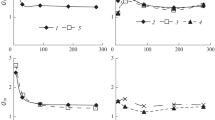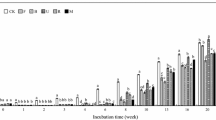Summary
The nitrogen absorbed by birch seedlings grown in sand culture has been used as a measure of the resistance to decomposition of complexes formed in vitro by interaction between protein and water-extractable leaf constituents ofCalluna vulgaris, Chamaenerion angustifolium andCircaea lutetiana. The resistance to decomposition of these complexes measured in this way isCalluna vulgaris >Chamaenerion angustifolium >Circaea lutetiana. This result seems to be in agreement with the soil-forming and field characteristics of these species and especially the raw humus-forming tendencies ofCalluna vulgaris.
The nitrogen released, as measured by the nitrogen absorbed by birch seedlings, fromCalluna raw humus (H-layer material) and the model protein —Calluna leaf extractives complex is very nearly proportional to the widely different amounts of total nitrogen initially added to the root environment thereby suggesting that the organic nitrogen of the model complex and of theCalluna raw humus have similar properties.
The amount of nitrogen absorbed by the birch seedlings when unaltered protein was added to the sand culture was less than when protein —Circaea lutetiana leaf extractives complex was added. This is ascribed to too rapid release and loss of nitrogen before it could be absorbed by the birch seedling roots and suggests a role for some leaf protein complexes in the conservation of litter nitrogen. Some possible effects of protein complexes in relation to the digestion of fresh and dry leaf material of various plant species by animals are discussed.
Information from archeological observations and from investigations into the tanning of proteins is considered in relation to possible factors influencing the decomposition of protein complexes of litter and it seems probable that a less acid reaction,e.g. such as is brought about by the addition of adequate amounts of calcareous material, will assist the mobilization of the nitrogen of raw-humus-forming litter.
The contention that the protein-precipitating substances of leaves are of fundamental importance in soil processes, especially raw humus formation and the supply of nutrients for plant growth, is considered to be supported by experimental approaches from different directions.
Similar content being viewed by others
References
Armstrong, D. G. and Thomas, B., The nutritive value ofCalluna vulgaris. II. A preliminary study of digestibility. J. Agr. Sci.43, 223–228 (1953).
Bate-Smith, E. C., Chromatography and systematic distribution of ellagic acid. Chemistry and Industry B.I.F. Review R32–R33 (1956)
Beijerinck, M. W., Pigments as products of oxidation by bacterial action. Koninkl. Akad. Wetenschap. Amsterdam13, 1066–1077 (1911).
Cadman, C. H., Some properties of an inhibitor of virus infection from leaves of raspberry. J. Gen. Microbiol.20, 113–138 (1959).
Chalmers, Margaret I. and Synge, R. L. M., The digestion of protein and nitrogenous compounds in ruminants. Advances in Protein Chem.9, 93–120 (1954)
Colin-Russ, A., A contribution to the study and control of mould growth in leather and other materials. J. Intern. Soc. Leather Trades' Chemists24, 395 (1940).
Curtis, O. F. and Clark, D. G., An Introduction to Plant Physiology. McGraw Hill Book Co., Inc., (1950).
Fenton, R. T., A laboratory study of nitrogen mobilization during litter decomposition. Plant and Soil9, 202–214 (1958).
Folgado, J. dos S.C., Digestibilidade e valor alimentar das folhas do ulmeiro e choupo. Estud. Inform. Serv. flor. aquic. Portugal No.104-G3, 1–16 (1959).
France-Lanord, A., La plaque-boucle mérovingienne de Saint-Quentin. Compt. rend. acad. inscriptions1956, 263–267 (1956).
Gansser, A., The early history of tanning, preservation of skins and leather. Ciba Rev. No.81, 2960–2962 (1950).
Gustavson, K. H., Behaviour of collagen in combination with tanning agents towards trypsin. Svensk Kem. Tidskr.54, 249–256 (1942).
Gustavson, K. H., The Chemistry of Tanning Processes. Academic Press Inc. London (1956).
Handley, W. R. C., Mull and mor formation in relation to forest soils. Forestry Commission Bull. No.23 (1954).
Hathway, D. E. and Seakins, J. W. T., Enzymic oxidation of catech in to a polymer structurally related to some phlobatannins. Biochem. J.67, 239–245 (1957).
Hattori, S. and Noguchi, I., Microbial degradation of rutin. Nature185, 1145 (1959).
Howes, F. N., Vegetable Tanning Materials. Butterworths Scientific Publications, London (1953).
Ingestad, T., Studies on the nutrition of forest tree seedlings. I: Mineral nutrition of birch. Physiol. Plantarum10, 418–439 (1957).
Ingestad, T., Studies on the nutrition of forest tree seedlings. II: Mineral nutrition of spruce. Physiol. Plantarum12, 568–593 (1959).
King, H. G. C. and White, T., Tannins and polyphenols ofSchinopsis (Quebracho) spp. their genesis and inter-relationship. J. Soc. Leather Trades' Chemists41, 368–383 (1957).
Kozlowski, T. T., Light and water in relation to growth and competition of Piedmont forest tree species.Ecol. Monographs 19, 207–231 (1949).
Love, C. W. and Brown, B. R., Substances in leaves affecting the decomposition of litter Forestry Commission Rep. Forest Research1959, 104–109 (1960).
Lugg, J. W. H., Plant proteins. Advances in Protein Chem.5, 229–304 (1949).
McDonald, I. W., The absorption of ammonia from the rumen of the sheep. Biochem. J.42, 584–587 (1948).
Mejbaum-Katzenellenbogen, W., Dobryszycka, W., Boguslawska-Jaworska, J., and Morowiecka, B., Regeneration of protein from insoluble proteintannin compounds. Nature184, 1799–1800 (1959).
Melin, E., Transfer of radioactive phosphorous to pine seedlings by means of mycorrhizal hyphae. Physiol. Plantarum3, 88–99 (1950).
Mikola, P., On the physiology and ecology ofCenococcum graniforme especially as a mycorrhizal fungus of birch. Commun. Inst. Forestales Fenniae36, 7–104 (1948).
Ministry of Works, Press Notice 10/60 EG. 154/1.
Möller, A., Ein neues Vegetationshaus und seine praktische Erprobung. Z. Forst- u. Jagdwesen40, 527–538 (1912).
National Museum, Copenhagen, Guide to the Antiquity Collections (1938).
Peart, J. N., The effect of heather on the growth of hill lambs. J. Brit. Grassland Soc.6, 219–228 (1951).
Phillips, H., The chemistry of leather. J. Roy. Soc. Arts C11, 824–875 (1954).
Roux, D. G., Molecular weight of condensed tannins as a factor determining their affinity for collagen. Nature181, 1793 (1958).
Stokar, W. von, Vorgeschichtliche Lederfunde und Lederverwendung. Collegium No.796, 433–437 (1936).
Somerfield, G. A., D. Phil. Thesis Univ. of Oxford (1959).
Tamm, C. O., Seasonal variation in the composition of birch leaves. Physiol. Plantarum4, 461–469 (1951).
Tamm, C. O., The response ofChamaenerion angustijolium (L.) Scop. to different nitrogen sources in water culture. Physiol. Plantarum9, 331–337 (1956).
Thomas, B., Heather (Calluna vulgaris) as a food for livestock. Herbage Abstr.26 1–7 (1956).
Thomas, B. and Smith, A. N., The nutritive value ofCalluna vulgaris. III Digestibility at four and ten years after burning. J. Agr. Sci.45, 104–109 (1959).
Vukavić, D. V. and Maksimović, D., Prilog poznavanju svarljivosti i hranljive vrednosti hrastavog i jasenovog lisnika. Arhiv Poljoprivredne Nauke i Tehniku.9, 59–76 (1956).
White, T., The Chemistry of Vegetable Tannins. A Symposium. Society of Leather Trades' Chemists. Croydon (1956).
Wilkins, H. L., Bates, R. P., Henson, P. R., Lindahl, I. L., and Davis, R. E., Tannin and palatability inSericea lespedeza (Lespedeza cuneata). Agron. J.45, 335–336 (1953).
Williams, R. T., Detoxication Mechanisms. Chapman and Hall Ltd, London (1959).
Author information
Authors and Affiliations
Rights and permissions
About this article
Cite this article
Handley, W.R.C. Further evidence for the importance of residual leaf protein complexes in litter decomposition and the supply of nitrogen for plant growth. Plant Soil 15, 37–73 (1961). https://doi.org/10.1007/BF01421749
Received:
Issue Date:
DOI: https://doi.org/10.1007/BF01421749




